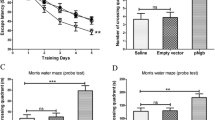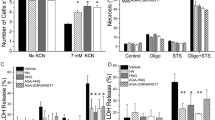Abstract
Humanin (HN) is a novel neuroprotective factor that consists of 24 amino acid residues. HN suppresses neuronal cell death caused by Alzheimer’s disease (AD)-specific insults, including both amyloid-β (βAβ) peptides and familial AD-causative genes. Cerebrovascular smooth muscle cells are also protected from Aβ toxicity by HN, suggesting that HN affects both neuronal and non-neuronal cells when they are exposed to AD-related cytotoxicity. HN peptide exerts a neuroprotective effect through the cell surface via putative receptor(s). HN activates a cellular signaling cascade that intervenes (at least) in activation of c-Jun N-terminal kinase. The highly selective effect of HN on AD-relevant cell death indicates that HN is promising for AD therapy. Additionally, a recent study showed that intracellularly overexpressed HN suppressed mitochondria-mediated apoptosis by inhibiting Bax activity.
Similar content being viewed by others
References
Hashimoto Y., Niikura T., Ito Y., and Nishimoto I. (2000) Multiple mechanisms underlie neurotoxicity by different types of Alzheimer’s disease mutations of amyloid precursor protein. J. Biol. Chem. 275, 34,541–34,551.
Hashimoto Y., Ito Y., Arakawa E., et al. (2002) Neurotoxic mechanisms triggered by Alzheimer’s disease-linked mutant M146L presenilin 1: involvement of NO synthase via a novel pertussis toxin target. J. Neurochem. 80, 426–437.
Hashimoto Y., Niikura T., Ito Y., Kita Y., Terashita K., and Nishimoto I. (2002) Neurotoxic mechanisms by Alzheimer’s disease-linked N141I mutant presenilin2. J. Pharmacol. Exp. Ther. 300, 736–745.
Niikura T., Hashimoto Y., Tajima H., and Nishimoto I. (2002) Death and survival of neuronal cells exposed to Alzheimer’s insults. J. Neurosci. Res. 70, 380–391.
Vito P., Lacana E., and D’Adamio L. (1996) Interfering with apoptosis: Ca(2+)-binding protein ALG-2 and Alzheimer’s disease gene ALG-3. Science 271, 521–525.
Hashimoto Y., Niikura T., Tajima H., et al. (2001) A rescue factor abolishing neuronal cell death by a wide spectrum of familial Alzheimer’s disease genes and Aβ. Proc. Natl. Acad. Sci. USA 98, 6336–6341. Correction in: Proc. Natl. Acad. Sci. USA 98, 12,854.
Yamagishi Y., Hashimoto Y., Niikura T., and Nishimoto I. (2003) Identification of essential amino acids in Humanin, a neuroprotective factor against Alzheimer’s disease relevant insults. Peptides 24, 585–595.
von Heijne G. (1985) Signal sequences. The limits of variation. J. Mol. Biol. 184, 99–105.
Hashimoto Y., Niikura T., Ito Y., et al. (2001) Detailed characterization of neuroprotection by a rescue factor Humanin against various Alzheimer’s disease-relevant insults. J. Neurosci. 21, 9235–9245.
Caricasole A., Bruno V., Cappuccio I., Melchiorri D., Copani A., and Nicoletti F. (2002) A novel rat gene encoding a Humanin-like peptide endowed with broad neuroprotective activity. FASEB J. 16, 1331–1333.
Terashita K., Hashimoto Y., Niikura T., et al. (2003) Two serine residues distinctly regulate the rescue function of Humanin, an inhibiting factor of Alzheimer’s disease-related neurotoxicity: functional potentiation by isomerization and dimerization. J. Neurochem. 85, 1521–1538.
Wolosker H., Blackshaw S., and Snyder S. H. (1999) Serine racemase: a glial enzyme synthesizing d-serine to regulate glutamate-N-methyl-d-aspartate neurotransmission. Proc. Natl. Acad. Sci. USA 96, 13,409–13,414.
Hashimoto Y., Ito Y., Niikura T., et al. (2001) Mechanisms of neuroprotection by a novel rescue factor Humanin from Swedish mutant amyloid precursor protein. Biochem. Biophys. Res. Commun. 283, 460–468.
Kawasumi M., Hashimoto Y., Chiba T., et al. (2002) Molecular mechanisms for meuronal cell death by Alzheimer’s amyloid precursor protein relevant insults. NeuroSignals 11, 236–250.
Yaar M., Zhai S., Pilch P. F., et al. (1997) Binding of β-amyloid to the p75 neurotrophin receptor induces apoptosis. A possible mechanism for Alzheimer’s disease. J. Clin. Invest. 100, 2333–2340.
Kuner P. and Hertel C. (1998) NGF induces apoptosis in a human neuroblastoma cell line expressing the neurotrophin receptor p75NTR. J. Neurosci. Res. 54, 465–474.
Tsukamoto E., Hashimoto Y., Kanekura K., Niikura T., Aiso S., and Nishimoto I. (2003) Characterization of the toxic mechanism triggered by Alzheimer’s amyloid-β peptides via p75 neurotrophin receptor in neuronal hybrid cells. J. Neurosci. Res. 73, 627–636.
Dore S., Kar S., and Quirion R. (1997) Insulin-like growth factor I protects and rescues hippocampal neurons against β-amyloid- and human amylin-induced toxicity. Proc. Natl. Acad. Sci. USA 94, 4772–4777.
Mark R. J., Keller J. N., Kruman I., and Mattson M. P. (1997) Basic FGF attenuates amyloid betapeptide-induced oxidative stress, mitochondrial dysfunction, and impairment of Na+/K+-ATPase activity in hippocampal neurons. Brain Res. 756, 205–214.
Vinters H. V. (1987) Cerebral amyloid angiopathy. A critical review. Stroke 18, 311–324.
Jung S. S. and Van Nostrand W. E. (2003) Humanin rescues human cerebrovascular smooth muscle cells from Aβ-induced toxicity. J. Neurochem. 84, 266–272.
Rosen D. R., Siddique T., Patterson D., et al. (1993) Mutations in Cu/Zn superoxide dismutase gene are associated with familial amyotrophic lateral sclerosis. Nature 362, 59–62. Erratum in: Nature (1993) 364, 362.
Kariya S., Takahashi N., Ooba N., Kawahara M., Nakayama H., and Ueno S. (2002) Humanin inhibits cell death of serum-deprived PC12h cells. Neuroreport 13, 903–907.
Niikura T., Hashimoto Y., Okamoto T., et al. (2001) Insulin-like growth factor I (IGF-I) protects cells from apoptosis by Alzheimer’s V642I mutant APP through IGF-I receptor in an IGF-binding protein-sensitive manner. J. Neurosci. 21, 1902–1910.
Hashimoto Y., Tsuji O., Niikura T., et al. (2003) Involvement of c-Jun N-terminal kinase in amyloid precursor protein-mediated neuronal cell death. J. Neurochem. 84, 864–877.
Wei W., Wang X., and Kusiak J. W. (2002) Signaling events in amyloid β-peptide-induced neuronal death and insulin-like growth factor I protection. J. Biol. Chem. 277, 17,649–17,656.
Sudo H., Jiang H., Yasukawa T., et al. (2000) Antibody regulated neurotoxic function of cell surface β-amyloid precursor protein. Mol. Cell. Neurosci. 16, 708–723.
Rohn T. T., Ivins K. J., Bahr B. A., Cotman C. W., and Cribbs D. H. (2000) A monoclonal antibody to amyloid precursor protein induces neuronal apoptosis. J. Neurochem. 74, 2331–2342.
Yamatsuji T., Matsui T., Okamoto T., et al. (1996) G protein-mediated neuronal DNA fragmentation induced by familial Alzheimer’s diseaseassociated mutants of APP. Science 272, 1349–1352.
Giambarella U., Yamatsuji T., Okamoto T., et al. (1997) G protein βγ complex-mediated apoptosis by familial Alzheimer’s disease mutant of APP. EMBO J. 16, 4897–4907.
Niikura T., Yamada M., Chiba T., Aiso S., Matsuoka M., and Nishimoto I. (2004) Characterization of V642I-AβPP-induced cytotoxicity in primary neurons. J. Neurosci. Res. 77, 54–62.
Hashimoto Y., Niikura T., Chiba T., et al. (2003) The cytoplasmic domain of Alzheimer’s amyloid-β protein precursor causes sustained ASK1/JNK-mediated neurotoxic signal via dimerization. J. Pharmacol. Exp. Ther. 306, 889–902.
Guo B., Zhai D., Cabezas E., et al. (2003) Humanin peptide suppresses apoptosis by interfering with Bax activation. Nature 423, 456–461.
Zhang Y., McLaughlin R., Goodyer C., and LeBlanc A. (2002) Selective cytotoxicity of intracellular amyloid β peptide1–42 through p53 and Bax in cultured primary neurons. J. Cell Biol. 156, 519–529.
Selznick L. A., Zheng T. S., Flavell R. A., Rakic P., and Roth K. A. (2000) Amyloid β-induced neuronal death is Bax-dependent but caspase-independent. J. Neuropath. Exp. Neurol. 59, 271–279.
Tajima H., Niikura T., Hashimoto Y., et al. (2002) Evidence for in vivo production of Humanin peptide, a neuroprotective factor against Alzheimer’s disease-related insults. Neurosci. Lett. 324, 227–231.
Niikura T., Hashimoto Y., Tajima H., et al. (2003) A tripartite motif protein TRIM11 binds and destabilizes Humanin, a neuroprotective peptide against Alzheimer’s disease-relevant insults. Eur. J. Neurosci. 17, 1150–1158.
Keller J. N., Hanni K. B., and Markesbery W. R. (2000) Impaired proteasome function in Alzheimer’s disease. J. Neurochem. 75, 436–439.
Lopez-Salon M., Morelli L., Castano E. M., Soto E. F., and Pasquini J. M. (2000) Defective ubiquitination of cerebral proteins in Alzheimer’s disease. J. Neurosci. Res. 62, 302–310.
Ikonen M., Liu B., Hashimoto Y., et al. (2003) Interaction between the Alzheimer’s survival peptide humanin and insulin-like growth factor-binding protein 3 regulates cell curvival and apoptosis. Proc. Natl. Acad. Sci. USA 100, 13,042–13,047.
Mamiya T. and Ukai M. (2001) [Gly(14)]-Humanin improved the learning and memory impairment induced by scopolamine in vivo. Br. J. Pharmacol. 134, 1597–1599.
Tajima H., Kawasumi M., Chiba T., et al. A humanin derivative, S14G-HN, prevents amyloid-β-induced memory impairment in mice. J. Neurosci. Res. in press.
Author information
Authors and Affiliations
Corresponding authors
Rights and permissions
About this article
Cite this article
Niikura, T., Chiba, T., Aiso, S. et al. Humanin. Mol Neurobiol 30, 327–340 (2004). https://doi.org/10.1385/MN:30:3:327
Received:
Accepted:
Issue Date:
DOI: https://doi.org/10.1385/MN:30:3:327




